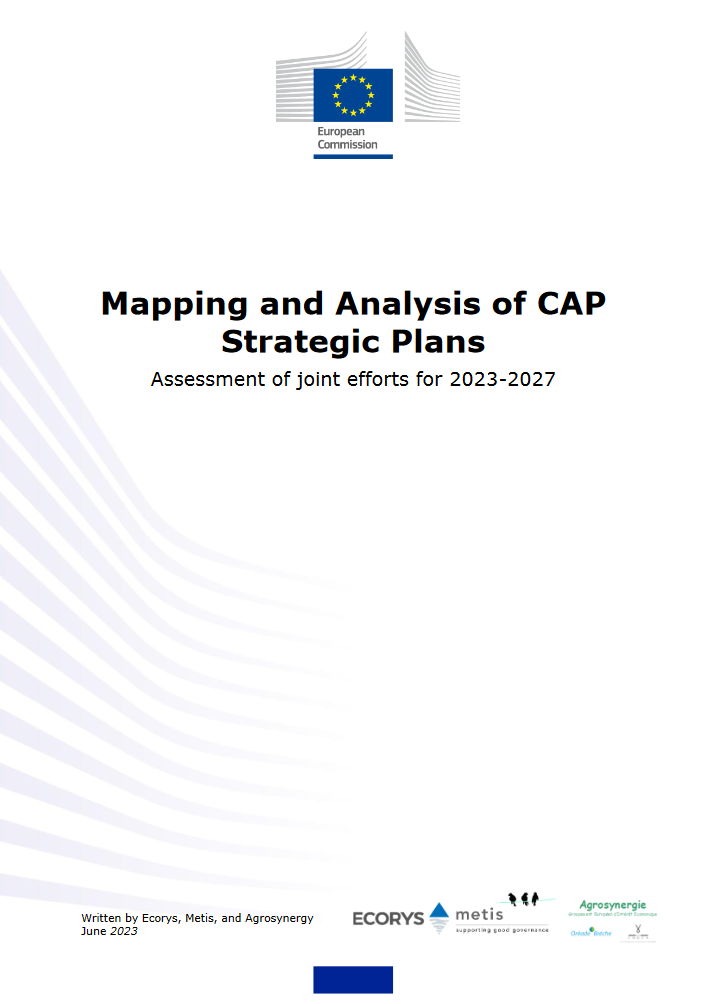Mapping and Analysis of CAP Strategic Plans
Assessment of joint efforts for 2023-2027
- Publication
- Citation
European Commission, Directorate-General for Agriculture and Rural Development, Folkeson Lillo, C., Chartier, O., Valli, C. et al., Mapping and analysis of CAP strategic plans – Assessment of joint efforts for 2023-2027, Folkeson Lillo, C.(editor), Chartier, O.(editor), Publications Office of the European Union, 2023, https://data.europa.eu/doi/10.2762/71556
The Common Agricultural Policy (CAP) is a key lever to support the transition towards sustainable agricultural production in Europe. In this study published by the European Commission, a first assessment is made of the strategic decisions made by Member States for the use of EUR 307 billion in support of agriculture and rural areas between 2023 and 2027. It maps the choices made in the CAP Strategic Plans (CSP) approved in December 2022 and analyses the joint efforts and potential impacts of Member States’ choices in relation to the nine specific objectives and the cross-cutting objective, with a focus on selected Green Deal targets. Furthermore, the study carried out a detailed mapping of farm practices supported by conditionality, eco-schemes, Envclim and investment interventions.
Key conclusions from the study include:
- EU countries still prioritize targeted income support for farmers, with about 60% of total CAP budget allocated to this Strategic Objective, with most interventions exclusively contributing to this SO. Environmental and climate commitments receive about 27% of total CAP budget each, with many interventions simultaneously contributing to several environmental Strategic Objectives.
- Investments focus on measures to foster productivity growth and the adoption of innovative technologies. Non-productive investments into green infrastructures, as well as those in infrastructure and basic services in rural areas receive comparatively less support.
- Most financial allocation for the new Green Architecture goes to Eco-schemes (EUR 44.7 billion, or 24% of Direct Payments, benefiting 70% of EU UAA), followed by ENVCLIM (agri-environment-climate commitments) (EUR 33.2 billion, or 30% of rural development including co-financing, benefiting 15% of UAA)
- The strengthening of conditionality has resulted in an overall increase in the environmental baseline, mainly with regards to soils and biodiversity preservation, nutrient pollution reduction and sustainable use of pesticides. Most CSPs have nevertheless opted for less ambitious design, and the increase in the baseline remains modest.
- The mapping of farm practices shows that the CSPs support many positive examples of measures supporting environmental objectives in eco-schemes, ENVCLIM and investment interventions. However, the overall impact of Member States' choices remains uncertain. Few CSPs present clear strategies to address the different environmental pressures posed by agriculture.
Ecologic Institute coordinated the mapping work for the three environmental objectives (climate, natural resources, biodiversity) and led the work on natural resources (water, soils, air) (CAP Strategic Objective 5). Ricardo led the work on mapping interventions on climate mitigation and adaptation (SO4) and IEEP led the work on biodiversity, habitats and ecosystem services (SO6). The study was led by Ecorys and involved other partners on the analysis of economic and social objectives.




